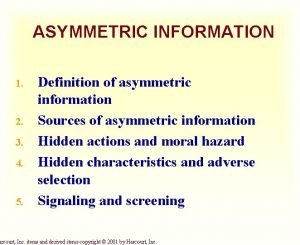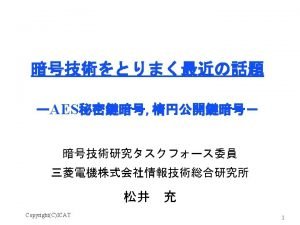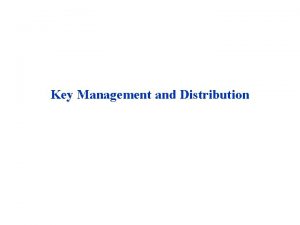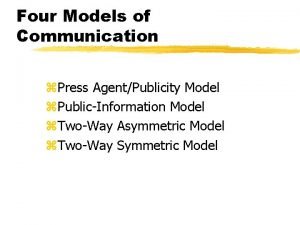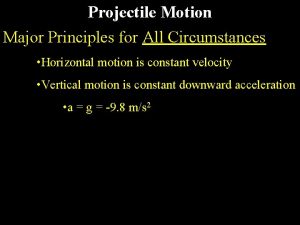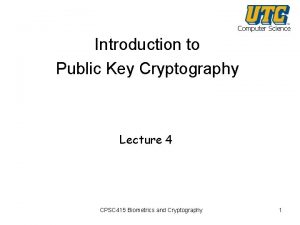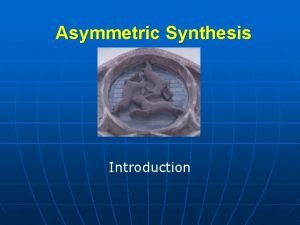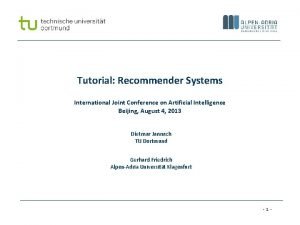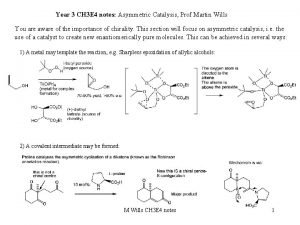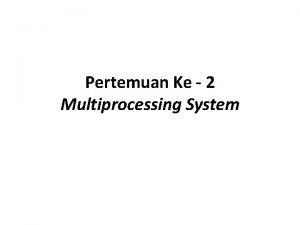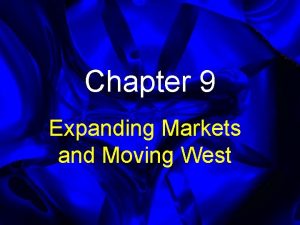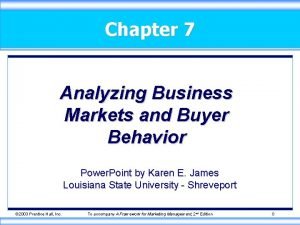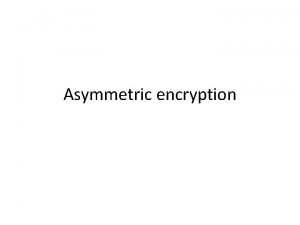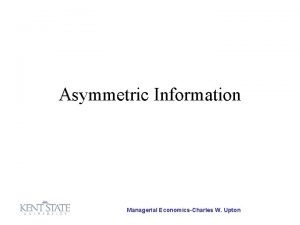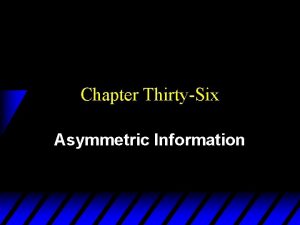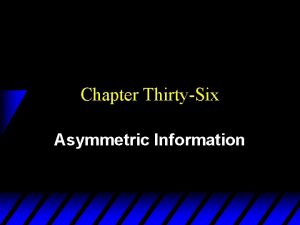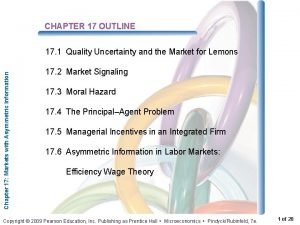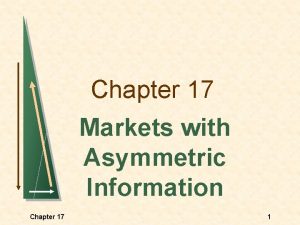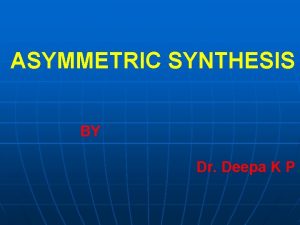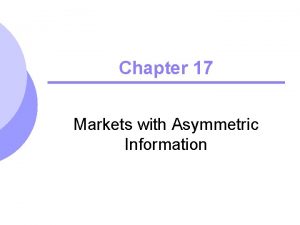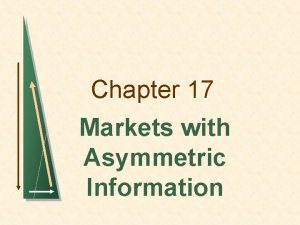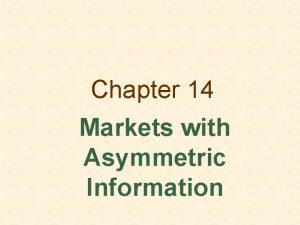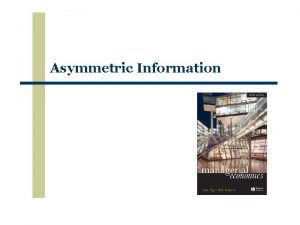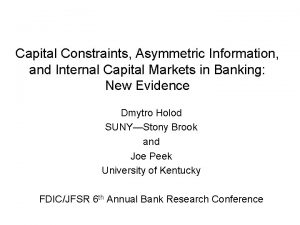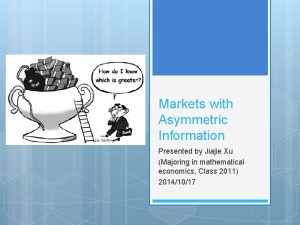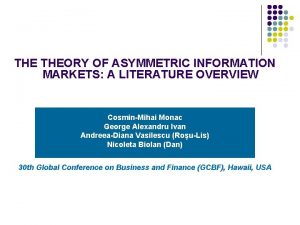CHAPTER 17 Markets with Asymmetric Information CHAPTER OUTLINE







































- Slides: 39

CHAPTER 17 Markets with Asymmetric Information CHAPTER OUTLINE 17. 1 Quality, Uncertainty and the Market for Lemons 17. 2 Market Signaling 17. 3 Moral Hazard 17. 4 The Principal–Agent Problem 17. 5 Managerial Incentives in an Integrated Firm 17. 6 Asymmetric Information in Labor Markets: Efficiency Wage Theory 17. 7 Why Markets Fail Prepared by: Fernando Quijano, Illustrator Copyright © 2015 Pearson Education • Microeconomics • Pindyck/Rubinfeld, 8 e, GE 1 of 39

17. 1 Quality Uncertainty and the Market for Lemons ● asymmetric information Situation in which a buyer and a seller possess different information about a transaction. Used cars sell for much less than new cars because there is asymmetric information about their quality: The seller of a used car knows much more about the car than the prospective buyer does. As a result, the prospective buyer will always be suspicious of its quality—and with good reason. The implications of asymmetric information about product quality were first analyzed by George Akerlof and go far beyond the market for used cars. The markets for insurance, financial credit, and even employment are also characterized by asymmetric information about product quality. Copyright © 2015 Pearson Education • Microeconomics • Pindyck/Rubinfeld, 8 e, GE 2 of 39

The Market for Used Cars Suppose two kinds of used cars are available—high-quality cars and lowquality cars. Also suppose that both sellers and buyers can tell which kind of car is which. There will then be two markets. In reality, the seller of a used car knows much more about its quality than a buyer does. (Buyers discover the quality only after they buy a car and drive it for a while. ) When making a purchase, buyers therefore view all cars as “medium quality, ” in the sense that there is an equal chance of getting a high-quality or a low-quality car. However, fewer high-quality cars and more low-quality cars will now be sold. As consumers begin to realize that most cars sold (about three-fourths of the total) are low quality, their perceived demand shifts. This shifting continues until only low-quality cars are sold. The lemons problem: With asymmetric information, low-quality goods can drive high-quality goods out of the market. Copyright © 2015 Pearson Education • Microeconomics • Pindyck/Rubinfeld, 8 e, GE 3 of 39

FIGURE 17. 1 (1 of 2) THE MARKET FOR USED CARS When sellers of products have better information about product quality than buyers, a “lemons problem” may arise in which low-quality goods drive out high quality goods. In (a) the demand curve for high-quality cars is DH. However, as buyers lower their expectations about the average quality of cars on the market, their perceived demand shifts to DM. Copyright © 2015 Pearson Education • Microeconomics • Pindyck/Rubinfeld, 8 e, GE 4 of 39

FIGURE 17. 1 (2 of 2) THE MARKET FOR USED CARS Likewise, in (b) the perceived demand curve for low-quality cars shifts from DL to DM. As a result, the quantity of high-quality cars sold falls from 50, 000 to 25, 000, and the quantity of low-quality cars sold increases from 50, 000 to 75, 000. Eventually, only low quality cars are sold. Copyright © 2015 Pearson Education • Microeconomics • Pindyck/Rubinfeld, 8 e, GE 5 of 39

Implications of Asymmetric Information Our used cars example shows how asymmetric information can result in market failure. Consumers cannot in fact easily determine the quality of a used car until after they purchase it. As a result, the price of used cars falls, and high-quality cars are driven out of the market. Market failure arises, therefore, because there are owners of high-quality cars who value their cars less than potential buyers of high-quality cars. Both parties could enjoy gains from trade, but, unfortunately, buyers’ lack of information prevents this mutually beneficial trade from occurring. ADVERSE SELECTION ● adverse selection Form of market failure resulting when products of different qualities are sold at a single price because of asymmetric information, so that too much of the low-quality product and too little of the high-quality product are sold. Copyright © 2015 Pearson Education • Microeconomics • Pindyck/Rubinfeld, 8 e, GE 6 of 39

THE MARKET FOR INSURANCE People who buy insurance know much more about their general health than any insurance company. As a result, adverse selection arises, much as it does in the market for used cars. Because unhealthy people are more likely to want insurance, the proportion of unhealthy people in the pool of insured people increases. This forces the price of insurance to rise, so that more healthy people, aware of their low risks, elect not to be insured. This further increases the proportion of unhealthy people among the insured, thus forcing the price of insurance up more. The process continues until most people who want to buy insurance are unhealthy. At that point, insurance becomes very expensive, or— in the extreme—insurance companies stop selling the insurance. One solution to the problem of adverse selection is to pool risks. For health insurance, the government might take on this role, as it does with the Medicare program. By providing insurance for all people over age 65, the government eliminates the problem of adverse selection. Likewise, insurance companies offer group health insurance policies at places of employment. By covering all workers in a firm, whether healthy or sick, the insurance company spreads risks and thereby reduces the likelihood that large numbers of high-risk individuals will purchase insurance. Copyright © 2015 Pearson Education • Microeconomics • Pindyck/Rubinfeld, 8 e, GE 7 of 39

THE MARKET FOR CREDIT How can a credit card company or bank distinguish high-quality borrowers (who pay their debts) from low-quality borrowers (who don’t)? Clearly, borrowers have better information—i. e. , they know more about whether they will pay than the lender does. Again, the lemons problem arises. Low-quality borrowers are more likely than high-quality borrowers to want credit, which forces the interest rate up, which increases the number of low-quality borrowers, which forces the interest rate up further, and so on. In fact, credit card companies and banks can, to some extent, use computerized credit histories, which they often share with one another, to distinguish low-quality from high-quality borrowers. Many people, however, think that computerized credit histories invade their privacy. Should companies be allowed to keep these credit histories and share them with other lenders? We can’t answer this question for you, but we can point out that credit Histories perform an important function: They eliminate, or at least greatly reduce, the problem of asymmetric information and adverse selection—a problem that might otherwise prevent credit markets from operating. Without these histories, even the creditworthy would find it extremely costly to borrow money. Copyright © 2015 Pearson Education • Microeconomics • Pindyck/Rubinfeld, 8 e, GE 8 of 39

The Importance of Reputation and Standardization Asymmetric information is also present in many other markets. Here are just a few examples: ● Retail stores: Will the store repair or allow you to return a defective product? ● Dealers of rare stamps, coins, books, and paintings: Are the items real or counterfeit? ● Roofers, plumbers, and electricians: When a roofer repairs or renovates the roof of your house, do you climb up to check the quality of the work? ● Restaurants: How often do you go into the kitchen to check if the chef is using fresh ingredients and obeying health laws? In all these cases, the seller knows much more about the quality of the product than the buyer does. Sellers of high-quality goods and services, therefore, have a big incentive to build a reputation. Since reputation may be difficult to build, standardization can solve the lemons problem. For example, you know exactly what you will be buying at Mc. Donald’s. Copyright © 2015 Pearson Education • Microeconomics • Pindyck/Rubinfeld, 8 e, GE 9 of 39

EXAMPLE 17. 1 MEDICARE Health care reform has been at the forefront of policy debates in the United States and worldwide for years. A core issue in the United States is whether everyone should have health insurance, and whether participation in some kind of public or private insurance program should be mandatory. Indeed, mandatory participation is what makes Medicare work. Remember that there is asymmetric information: people know much more about their health, than insurance companies can possibly know. Those seniors who have chronic diseases are much more likely to buy the insurance than those who are in excellent health and thus expect lower costs. This creates an adverse selection problem. All people over 65 participate in Medicare—those expecting low health care costs along with those who expect high costs. Of course, the low-cost participants are subsidizing those with high costs. But because adverse selection is not a problem with a mandatory program, the overall cost of Medicare is lower than the cost of most private insurance systems. Indeed, Medicare has earned a reputation as one of the most successful and efficient public programs in the United States. Copyright © 2015 Pearson Education • Microeconomics • Pindyck/Rubinfeld, 8 e, GE 10 of 39

EXAMPLE 17. 2 LEMONS IN MAJOR LEAGUE BASEBALL In a lemons market, because purchasers of secondhand products will have limited information, resold products should be lower in quality than products that rarely appear on the market. After six years of major league service, players can now sign new contracts with their original teams or become free agents and sign with new teams. The availability of many free agents creates a second-hand market in baseball players. Asymmetric information is prominent in the free-agent market. One potential purchaser, the player’s original team, has better information about the player’s abilities than other teams have. If a lemons market exists, we would expect free agents to have higher disability rates than players who are renewed. Less desirable candidates would become free agents. TABLE 17. 1 PLAYER DISABILITY DAYS SPENT ON DISABLED LIST PER SEASON PRECONTRACT POSTCONTRACT PERCENTAGE CHANGE All players 4. 73 12. 55 165. 4 Renewed players 4. 76 9. 68 103. 4 Free agents 4. 67 17. 23 268. 9 Copyright © 2015 Pearson Education • Microeconomics • Pindyck/Rubinfeld, 8 e, GE 11 of 39

17. 2 Market Signaling ● market signaling Process by which sellers send signals to buyers conveying information about product quality. What characteristics can a firm examine to obtain information about people’s productivity before it hires them? Can potential employees convey information about their productivity? Dressing well for the job interview might convey some information, but even unproductive people can dress well. Dressing well is thus a weak signal—it doesn’t do much to distinguish high-productivity from lowproductivity people. To be strong, a signal must be easier for high-productivity people to give than for low-productivity people to give, so that high-productivity people are more likely to give it. For example, education is a strong signal in labor markets. More productive people are more likely to attain high levels of education in order to signal their productivity to firms and thereby obtain better-paying jobs. Thus, firms are correct in considering education a signal of productivity. Copyright © 2015 Pearson Education • Microeconomics • Pindyck/Rubinfeld, 8 e, GE 12 of 39

A Simple Model of Job Market Signaling Let’s assume that there are only low-productivity workers (Group I), whose average and marginal product is 1, and high-productivity workers (Group II), whose average and marginal product is 2. Workers will be employed by competitive firms whose products sell for $10, 000, and who expect an average of 10 years’ work from each employee. We also assume that half the workers in the population are in Group I and the other half in Group II, so that the average productivity of all workers is 1. 5. Note that the revenue expected to be generated from Group I workers is $100, 000 ($10, 000/year * 10 years) and from Group II workers is $200, 000 ($20, 000/year * 10 years). If firms could identify people by their productivity, they would offer them a wage equal to their marginal revenue product. Group I people would be paid $10, 000 per year, Group II people $20, 000. On the other hand, if firms could not identify productivity before they hired people, they would pay all workers an annual wage equal to the average productivity—$15, 000. Group I people would then earn more ($15, 000 instead of $10, 000), at the expense of Group II people (who would earn $15, 000 instead of $20, 000). Copyright © 2015 Pearson Education • Microeconomics • Pindyck/Rubinfeld, 8 e, GE 13 of 39

What is important is that the cost of education is greater for the lowproductivity group than for the high-productivity group. In particular, suppose that for each group, the cost of attaining educational level y is given by • • Now suppose (to keep things simple and to dramatize the importance of signaling) that education does nothing to increase one’s productivity; its only value is as a signal. EQUILIBRIUM Suppose firms use this decision rule: Anyone with an education level of y* or more is a Group II person and is offered a wage of $20, 000, while anyone with an education level below y* is a Group I person and is offered a wage of $10, 000. The particular level y* that the firms choose is arbitrary, but for this decision rule to be part of an equilibrium, firms must have identified people correctly. We must determine how much education the people in each group will obtain, given that firms are using this decision rule. The benefit of education B(y) is the increase in the wage associated with each level of education. Copyright © 2015 Pearson Education • Microeconomics • Pindyck/Rubinfeld, 8 e, GE 14 of 39

FIGURE 17. 2 SIGNALING Education can be a useful signal of the high productivity of a group of workers if education is easier to obtain for this group than for a low-productivity group. In (a), the low-productivity group will choose an education level of y = 0 because the cost of education is greater than the increased earnings resulting from education. However, in (b), the high-productivity group will choose an education level of y* = 4 because the gain in earnings is greater than the cost. Copyright © 2015 Pearson Education • Microeconomics • Pindyck/Rubinfeld, 8 e, GE 15 of 39

COST–BENEFIT COMPARISON People in each group make the following cost-benefit calculation: Obtain the education level y* if the benefit (i. e. , the increase in earnings) is at least as large as the cost of this education. Therefore, Group I will obtain no education as long as • and Group II will obtain an education level y* as long as • These results give us an equilibrium as long as y* is between 2. 5 and 5. When the firm interviews people who have four years of college, it correctly assumes their productivity is high, warranting a wage of $20, 000. We therefore have an equilibrium. High-productivity people will obtain a college education to signal their productivity; firms will read this signal and offer them a high wage. Copyright © 2015 Pearson Education • Microeconomics • Pindyck/Rubinfeld, 8 e, GE 16 of 39

Guarantees and Warranties Consider the markets for such durable goods as televisions, stereos, cameras, and refrigerators. Many firms produce these items, but some brands are more dependable than others. If consumers could not tell which brands tend to be more dependable, the better brands could not be sold for higher prices. Firms that produce a higher-quality, more dependable product must therefore make consumers aware of this difference. But how can they do it in a convincing way? The answer is guarantees and warranties. Guarantees and warranties effectively signal product quality because an extensive warranty is more costly for the producer of a low-quality item than for the producer of a high-quality item. The low-quality item is more likely to require servicing under the warranty, for which the producer will have to pay. In their own self-interest, therefore, producers of low-quality items will not offer extensive warranties. Thus consumers can correctly view extensive warranties as signals of high quality and will pay more for products that offer them. Copyright © 2015 Pearson Education • Microeconomics • Pindyck/Rubinfeld, 8 e, GE 17 of 39

EXAMPLE 17. 3 WORKING INTO THE NIGHT It may take several years for a firm to recognize someone’s talent. Given this asymmetric information, what policy should employers use to determine promotions and salary increases? Can workers who are unusually talented and productive signal this fact and thereby receive earlier promotions and larger salary increases? Workers can often signal talent and productivity by working harder and longer hours. Because more talented and productive workers tend to get more enjoyment and satisfaction from their jobs, it is less costly for them to send this signal than it is for other workers. Many young lawyers, accountants, consultants, investment bankers, and computer programmers regularly work into the night and on weekends, putting in 60 - or 70 -hour weeks. They are trying to send signals that can greatly affect their careers. Employers rely increasingly on the signaling value of long hours as rapid technological change makes it harder for them to find other ways of assessing workers’ skills and productivity. Copyright © 2015 Pearson Education • Microeconomics • Pindyck/Rubinfeld, 8 e, GE 18 of 39

17. 3 Moral Hazard ● moral hazard When a party whose actions are unobserved can affect the probability or magnitude of a payment associated with an event. The possibility that an individual’s behavior may change because she has insurance is an example of a problem known as moral hazard. The concept of moral hazard applies not only to problems of insurance, but also to problems of workers who perform below their capabilities when employers cannot monitor their behavior (“job shirking”). Moral hazard is a problem not only for insurance companies. It also alters the ability of markets to allocate resources efficiently. Copyright © 2015 Pearson Education • Microeconomics • Pindyck/Rubinfeld, 8 e, GE 19 of 39

FIGURE 17. 3 THE EFFECTS OF MORAL HAZARD Moral hazard alters the ability of markets to allocate resources efficiently. D gives the demand for automobile driving. With no moral hazard, the marginal cost of transportation MC is $1. 50 per mile; the driver drives 100 miles, which is the efficient amount. With moral hazard, the driver perceives the cost per mile to be MC = $1. 00 and drives 140 miles. Copyright © 2015 Pearson Education • Microeconomics • Pindyck/Rubinfeld, 8 e, GE 20 of 39

EXAMPLE 17. 4 REDUCING MORAL HAZARD: WARRANTIES OF ANIMAL HEALTH For buyers of livestock, information about the animals’ health is very important. Because of asymmetric information in the livestock market, most states require warranties on the sale of livestock. Although warranties solve the problem of the seller having better information than the buyer, they also create a form of moral hazard. In response to the moral hazard problem, many states have modified their animal warranty laws by requiring sellers to tell buyers whether livestock are diseased at the time of sale. Copyright © 2015 Pearson Education • Microeconomics • Pindyck/Rubinfeld, 8 e, GE 21 of 39

17. 4 The Principal–Agent Problem ● principal–agent problem Problem arising when agents (e. g. , a firm’s managers) pursue their own goals rather than the goals of principals (e. g. , the firm’s owners). An agency relationship exists whenever there is an arrangement in which one person’s welfare depends on what another person does. ● agent Individual employed by a principal to achieve the principal’s objective. A principal–agent problem arises when agents pursue their own goals rather than the goals of the principal. ● principal Individual who employs one or more agents to achieve an objective. Copyright © 2015 Pearson Education • Microeconomics • Pindyck/Rubinfeld, 8 e, GE 22 of 39

The Principal–Agent Problem in Private Enterprises Managers can often pursue their own objectives, rather than focusing on the objective of the stockholders, which is to maximize the value of the firm. One view is that managers are more concerned with rapid growth and larger market share, which provide more cash flow and in turn allows managers to enjoy more perks. Another view emphasizes the utility that managers get from their jobs, the power to control the corporation, the fringe benefits and other perks, and long job tenure. However, there are limitations to managers’ ability to deviate from the objectives of owners. First, stockholders can complain loudly when they feel that managers are behaving improperly. Second, a vigorous market for corporate control can develop unless managers pursue the goal of profit maximization. Third, there can be a highly developed market for managers. If managers who maximize profit are in great demand, they will earn high wages and so give other managers an incentive to pursue the same goal. Copyright © 2015 Pearson Education • Microeconomics • Pindyck/Rubinfeld, 8 e, GE 23 of 39

EXAMPLE 17. 5 CEO SALARIES CEO compensation has increased sharply over the past few decades. The average annual salary for production workers in the U. S. went from $18, 187 in 1990 to $32, 093 in 2009. But in constant dollar terms, the 2009 average salary was only $19, 552 (in 1990 dollars), which represents only a 7. 5% increase. At the same time, the average annual compensation for CEOs has grown from $2. 9 million to $8. 5 million, or about $5. 2 million in 1990 dollars. In other words, while production workers have seen a 7. 5% increase in their real wages over the past two decades, real CEO compensation has risen nearly 80%. Why? Have top managers become more productive, or are CEOs simply becoming more effective at extracting economic rents from their companies? The answer lies in the principal–agent problem, which is at the heart of CEO salary determination. Copyright © 2015 Pearson Education • Microeconomics • Pindyck/Rubinfeld, 8 e, GE 24 of 39

EXAMPLE 17. 5 CEO SALARIES Managers have steadily increased their ability to extract economic rents. How has this happened? Most boards of directors do not have the necessary information or independence to negotiate effectively with managers. Directors often cannot monitor executives’ activities and therefore cannot negotiate compensation packages that are tightly linked to their performance. Research has shown that high levels of CEO pay are negatively correlated with a firm’s accounting value and profitability. In other words, the higher the CEO’s pay, the lower the firm’s profitability is likely to be. In addition, CEOs with unusually high pay were more likely to stay at a company despite poor economic results. These effects are intensified at companies where the board is entrenched and shareholder rights are limited. “Golden parachutes, ” generous severance packages that CEOs can negotiate with their boards, have also come under fire recently. Some argue that such guarantees free CEOs from board and shareholder pressure to focus on shortterm growth and enable them to focus instead on their firms’ long-term growth. However, it has been shown that CEOs with golden parachutes are less likely to worry about long-term growth, and—when negotiating the sale of their firm to another company—are more likely to agree to acquisition terms that hurt shareholders. Copyright © 2015 Pearson Education • Microeconomics • Pindyck/Rubinfeld, 8 e, GE 25 of 39

The Principal–Agent Problem in Public Enterprises Because it is also costly to monitor the behavior of public managers, there are no guarantees that they will produce the efficient output. Although the public sector lacks some of the market forces that keep private managers in line, government agencies can still be effectively monitored. First, managers of government agencies care about more than just the size of their agencies. Indeed, many choose lower-paying public jobs because they are concerned about the “public interest. ” Second, much like private managers, public managers are subject to the rigors of the managerial job market. If they are perceived to be pursuing improper objectives, their ability to obtain high salaries in the future might be impaired. Third, legislatures and other government agencies perform an oversight function. At the local rather than the federal level, public managers are subject to even more checks. Competition among agencies can be as effective as competition among private firms in constraining the behavior of managers. Copyright © 2015 Pearson Education • Microeconomics • Pindyck/Rubinfeld, 8 e, GE 26 of 39

EXAMPLE 17. 6 MANAGERS OF NONPROFIT HOSPITALS AS AGENTS In a study of 725 hospitals, from 14 major hospital chains, researchers compared the return on investment and average costs of nonprofit and for-profit hospitals to determine if they performed differently. The study found that the rates of return did indeed differ. A straight comparison of returns and costs is not appropriate, however, because the hospitals perform different functions. Using a statistical regression analysis, which controls for differences in the services performed, one can determine whether differences in services account for the higher costs. The study found that after adjusting for services performed, the average cost of a patient day in nonprofit hospitals was 8 percent higher than in for-profit hospitals. This difference implies that the profit status of the hospital affects its performance in the way principal–agent theory predicts: Without the competitive forces faced by for-profit hospitals, nonprofit hospitals may be less costconscious and therefore less likely to serve appropriately as agents for their principals—namely, society at large. Copyright © 2015 Pearson Education • Microeconomics • Pindyck/Rubinfeld, 8 e, GE 27 of 39

Incentives in the Principal–Agent Framework How can owners design reward systems so that managers and workers come as close as possible to meeting owners’ goals? TABLE 17. 2 REVENUE FROM MAKING WATCHES BAD LUCK GOOD LUCK Low effort (�= 0) $10, 000 $20, 000 High effort (�= 1) $20, 000 $40, 000 In this example, the owners’ goal is to maximize expected profit, given the uncertainty of outcomes and given the fact that the repairperson’s behavior cannot be monitored. We describe the payment scheme as w(R), stressing that payments can depend only on measured revenue. What is the best payment scheme? And can that scheme be as effective as one based on effort rather than output? The best payment scheme depends on the nature of production, the degree of uncertainty, and the objectives of both owners and managers. Facing a wage of 0, the repairperson has no incentive to make a high level of effort. A fixed payment will lead to an inefficient outcome. When a = 0 and w = 0, the owner will earn an expected revenue of $15, 000 and the repairperson a net wage of 0. Copyright © 2015 Pearson Education • Microeconomics • Pindyck/Rubinfeld, 8 e, GE 28 of 39

Incentives in the Principal–Agent Framework Both the owners and the repairperson will be better off if the repairperson is rewarded for his productive effort. Suppose, for example, that the owners offer the repairperson the following payment scheme: • (17. 1) • Under this bonus arrangement, a low effort generates no payment. A high effort, however, generates an expected payment of $12, 000, and an expected payment less the cost of effort of $12, 000 - $10, 000 = $2000. Under this system, the repairperson will choose to make a high level of effort. This arrangement makes the owners better off than before because they get an expected revenue of $30, 000 and an expected profit of $18, 000. Copyright © 2015 Pearson Education • Microeconomics • Pindyck/Rubinfeld, 8 e, GE 29 of 39

This is not the only payment scheme that will work for the owners, however. Suppose they contract to have the worker participate in the following revenue-sharing arrangement. When revenues are greater than $18, 000, • (17. 2) In this case, if the repairperson makes a low effort, he receives an expected payment of $1000. But if he makes a high level of effort, his expected payment is $12, 000, and his expected payment less the $10, 000 cost of effort is $2000. (The owners’ profit is $18, 000, as before. ) Thus, in our example, a revenue-sharing arrangement achieves the same outcome as a bonus-payment system. In more complex situations, the incentive effects of the two types of arrangements will differ. However, the basic idea illustrated here applies to all principal–agent problems: When it is impossible to measure effort directly, an incentive structure that rewards the outcome of high levels of effort can induce agents to aim for the goals that the owners set. Copyright © 2015 Pearson Education • Microeconomics • Pindyck/Rubinfeld, 8 e, GE 30 of 39

17. 5 Managerial Incentives in an Integrated Firm ● horizontal integration Organizational form in which several plants produce the same or related products for a firm. ● vertical integration Organizational form in which a firm contains several divisions, with some producing parts and components that others use to produce finished products. Asymmetric Information and Incentive Design in the Integrated Firm In an integrated firm, division managers have better information than central management has. This asymmetric information causes two problems. 1. How can central management elicit accurate information about divisional operating costs and production potential from divisional managers? 2. What reward or incentive structure should central management use to encourage divisional managers to produce as efficiently as possible? Copyright © 2015 Pearson Education • Microeconomics • Pindyck/Rubinfeld, 8 e, GE 31 of 39

Let’s examine ways in which central management can obtain the information it wants while also encouraging plant managers to run the plants as efficiently as possible. One way is to give plant managers bonuses based on either the total output of their plant or its operating profit. Although this approach would encourage managers to maximize output, it would penalize managers whose plants have higher costs and lower capacity. Plant managers would also have no incentive to obtain and reveal accurate information about cost and capacity. A second way is to ask managers about their costs and capacities and then base bonuses on how well they do relative to their answers. Copyright © 2015 Pearson Education • Microeconomics • Pindyck/Rubinfeld, 8 e, GE 32 of 39

For example, at the end of the year, the manager receives a bonus based on how close the plant’s output was to this target. If the manager’s estimate of the feasible production level is Qf, the annual bonus in dollars, B, might be • (17. 3) where Q is the plant’s actual output, 10, 000 is the bonus when output is at capacity, and. 5 is a factor chosen to reduce the bonus if Q is below Qf. The scheme above fails to elicit accurate information about capacity and does not ensure that plants will be run as efficiently as possible. In the scheme below, each manager has the incentive to reveal the true feasible production level and to make Q, the actual output of the plant, as large as possible. • (17. 4) • Copyright © 2015 Pearson Education • Microeconomics • Pindyck/Rubinfeld, 8 e, GE 33 of 39

FIGURE 17. 4 INCENTIVE DESIGN IN AN INTEGRATED FIRM A bonus scheme can be designed that gives a manager the incentive to estimate accurately the size of the plant. If the manager reports a feasible capacity of 20, 000 units per year, equal to the actual capacity, then the bonus will be maximized (at $6000). Copyright © 2015 Pearson Education • Microeconomics • Pindyck/Rubinfeld, 8 e, GE 34 of 39

Applications Because the problem of asymmetric information and incentive design comes up often in managerial settings, incentive schemes like the one described above arise in many contexts. How, for example, can managers encourage salespeople to set and reveal realistic sales targets and then work as hard as possible to meet them? Companies have always used bonuses and commissions to reward salespeople, but incentive schemes have often been poorly designed. Typically, salespeople’s commissions were proportional to their sales. This approach elicited neither accurate information about feasible sales targets nor maximum performance. Today, companies are learning that bonus schemes like the one given by equation (17. 4) provide better results. The salesperson can be given an array of numbers showing the bonus as a function of both the sales target (chosen by the salesperson) and the actual level of sales. (The numbers would be calculated from equation (17. 4) or some similar formula. ) Salespeople will quickly figure out that they do best by reporting feasible sales targets and then working as hard as possible to meet them. Copyright © 2015 Pearson Education • Microeconomics • Pindyck/Rubinfeld, 8 e, GE 35 of 39

17. 6 Asymmetric Information in Labor Markets: Efficiency Wage Theory ● efficiency wage theory Explanation for the presence of unemployment and wage discrimination which recognizes that labor productivity may be affected by the wage rate. In the presence of high unemployment, why don’t we see firms cutting wage rates, increasing employment levels, and thereby increasing profit? Can our models of competitive equilibrium explain persistent unemployment? ● shirking model Principle that workers still have an incentive to shirk if a firm pays them a market-clearing wage, because fired workers can be hired somewhere else for the same wage. Once hired, workers can either work productively or slack off (shirk). But because information about their performance is limited, workers may not get fired for shirking. Copyright © 2015 Pearson Education • Microeconomics • Pindyck/Rubinfeld, 8 e, GE 36 of 39

The model works as follows. If a firm pays its workers the market-clearing wage w*, they have an incentive to shirk. Even if they get caught and are fired (and they might not be), they can immediately get hired somewhere else for the same wage. Because threat of being fired does not impose a cost on workers, they have no incentive to be productive. As an incentive not to shirk, a firm must offer workers a higher wage. At this higher wage, workers who are fired for shirking will face a decrease in wages when hired by another firm at w*. If the difference in wages is large enough, workers will be induced to be productive, and the employer will not have a problem with shirking. ● efficiency wage Wage that a firm will pay to an employee as an incentive not to shirk. Up to this point, we have looked at only one firm. But all firms face the problem of shirking. All firms, therefore, will offer wages greater than the market-clearing wage w*—say, we (efficiency wage). Does this remove the incentive for workers not to shirk because they will be hired at the higher wage by other firms if they get fired? No. Because all firms are offering wages greater than w*, the demand for labor is less than the market-clearing quantity, and there is unemployment. Consequently, workers fired for shirking will face spells of unemployment before earning we at another firm. Copyright © 2015 Pearson Education • Microeconomics • Pindyck/Rubinfeld, 8 e, GE 37 of 39

FIGURE 17. 5 UNEMPLOYMENT IN A SHIRKING MODEL Unemployment can arise in otherwise competitive labor markets when employers cannot accurately monitor workers. Here, the “no shirking constraint” (NSC) gives the wage necessary to keep workers from shirking. The firm hires Le workers (at a higher than competitive efficiency wage we), creating L* − Le of unemployment. Copyright © 2015 Pearson Education • Microeconomics • Pindyck/Rubinfeld, 8 e, GE 38 of 39

EXAMPLE 17. 7 EFFICIENCY WAGES AT FORD MOTOR COMP ANY The introduction of the assembly line drastically changed the workplace. Now jobs demanded much less skill, and production depended on maintaining assembly-line equipment. In 1914, when the going wage for a day’s work in industry averaged between $2 and $3, Ford introduced a pay policy of $5 a day. The policy was prompted by improved labor efficiency, not generosity. The goal was to attract better workers who would stay with their jobs—and eventually to increase profits. Although Henry Ford was attacked for it, his policy succeeded. His workforce did become more stable, and the publicity helped Ford’s sales. In addition, because Ford had his pick of workers, he could hire a group that was on average more productive. Ford stated that the wage increase did in fact increase the loyalty and personal efficiency of his workers, and quantitative estimates support his statements. According to calculations by Ford’s chief of labor relations, productivity increased by 51 percent. Another study found that absenteeism had been cut in half and discharges for cause had declined sharply. Thus the productivity increase more than offset the increase in wages. As a result, Ford’s profitability rose from $30 million in 1914 to $60 million in 1916. Copyright © 2015 Pearson Education • Microeconomics • Pindyck/Rubinfeld, 8 e, GE 39 of 39
 Asymmetric information game theory
Asymmetric information game theory Asymmetric information diagram
Asymmetric information diagram Asymmetric information diagram
Asymmetric information diagram Disadvantages of asymmetric encryption
Disadvantages of asymmetric encryption Symmetric and asymmetric matrix
Symmetric and asymmetric matrix Introduction to corporate communication
Introduction to corporate communication Iugr full form
Iugr full form Asymmetric vlan
Asymmetric vlan Asymmetric communication
Asymmetric communication Vlan4094
Vlan4094 Definition of ihrm
Definition of ihrm Aes des
Aes des Ccna vlan
Ccna vlan Asymmetric vlan
Asymmetric vlan Key management and distribution
Key management and distribution Asymmetric encryption java
Asymmetric encryption java Two way asymmetrical model example
Two way asymmetrical model example Illusion of asymmetric insight
Illusion of asymmetric insight Hydroperoxides
Hydroperoxides Vy = voy + gt
Vy = voy + gt Cryptography computer science
Cryptography computer science Asymmetric synthesis example
Asymmetric synthesis example Asymmetric dominance effect
Asymmetric dominance effect Sharpless asymmetric epoxidation
Sharpless asymmetric epoxidation Selection rule for raman spectroscopy
Selection rule for raman spectroscopy Asymmetric key authentication
Asymmetric key authentication Asymmetric synthesis notes
Asymmetric synthesis notes Symmetric vs asymmetric encryption performance
Symmetric vs asymmetric encryption performance Perbedaan antara symmetric dan asymmetric multiprocessing
Perbedaan antara symmetric dan asymmetric multiprocessing Extreme spbm
Extreme spbm Asymmetric multicore processing
Asymmetric multicore processing Asymmetric bandwidth
Asymmetric bandwidth How to write a quote sandwich
How to write a quote sandwich Why study financial institutions
Why study financial institutions Cultural dynamics in assessing global markets
Cultural dynamics in assessing global markets Characteristics of buyer behaviour
Characteristics of buyer behaviour Chapter 9 expanding markets and moving west
Chapter 9 expanding markets and moving west Analyzing consumer and business markets
Analyzing consumer and business markets Characteristics of business buying behaviour
Characteristics of business buying behaviour Chapter 18 the markets for the factors of production
Chapter 18 the markets for the factors of production


